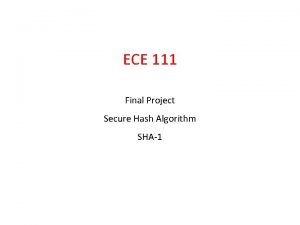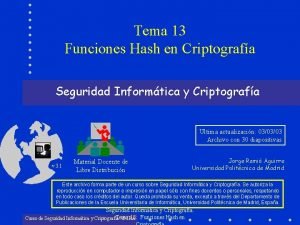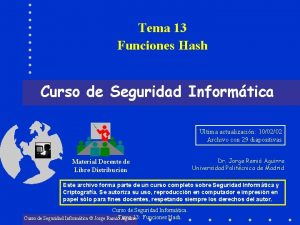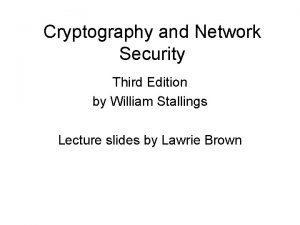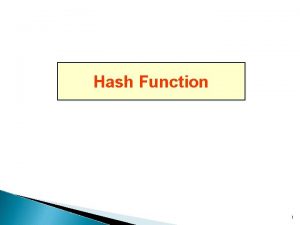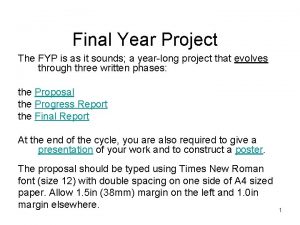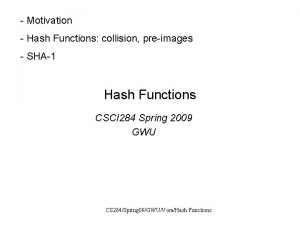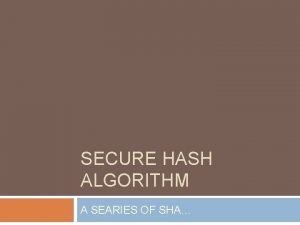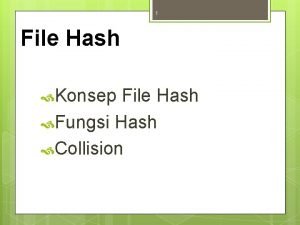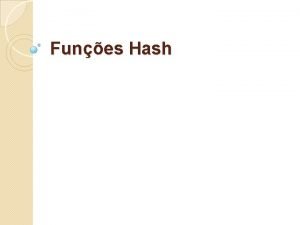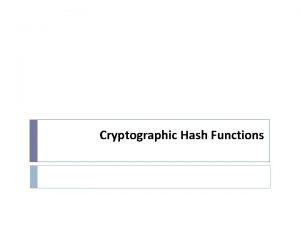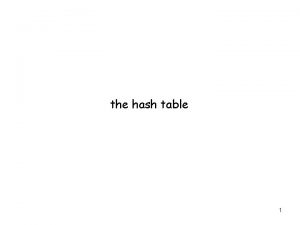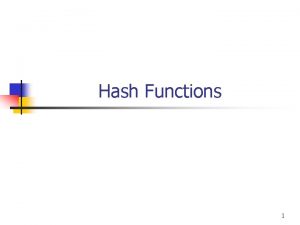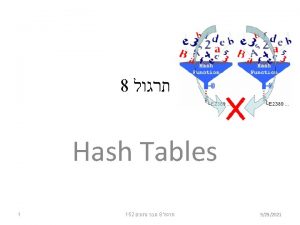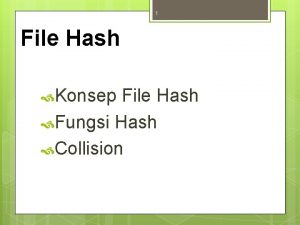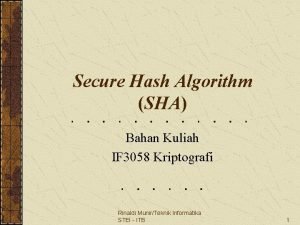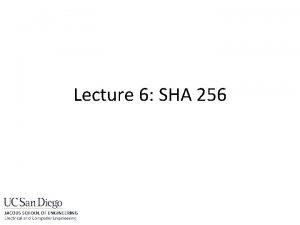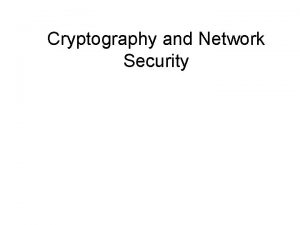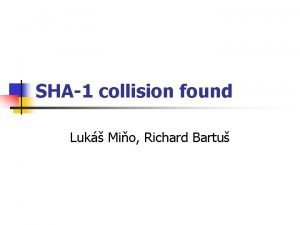ECE 111 Final Project Secure Hash Algorithm SHA1
















![Module Interface • Very similar to Project 2 on RLE Co-Processor Done Hash[159: 0] Module Interface • Very similar to Project 2 on RLE Co-Processor Done Hash[159: 0]](https://slidetodoc.com/presentation_image_h/c719c0210ade0c735b1c2c65ce4379d9/image-17.jpg)

![Big-Endian vs. Little-Endian • Use this function [31: 0] change. Endian; //transform to big-endian Big-Endian vs. Little-Endian • Use this function [31: 0] change. Endian; //transform to big-endian](https://slidetodoc.com/presentation_image_h/c719c0210ade0c735b1c2c65ce4379d9/image-19.jpg)



- Slides: 22

ECE 111 Final Project Secure Hash Algorithm SHA-1

Secure Hash Algorithm • Goal is to compute a unique hash value for any input “message”, where a “message” can be anything. • SHA-1 (widely used) returns a 160 -bit hash value (a. k. a. message digest or strong checksum) “The quick brown fox jumps over the lazy dog” SHA-1 2 fd 4 e 1 c 6 7 a 2 d 28 fc ed 849 ee 1 bb 76 e 739 1 b 93 eb 12 160 -bits = five 32 -bit words SHA-1 file: avatar. avi file: chopin. mp 3 some 160 -bit value SHA-1 some 160 -bit value

SHA-1 • Just a small change, e. g. from “dog” to “cog”, will completely change the hash value “The quick brown fox jumps over the lazy dog” SHA-1 2 fd 4 e 1 c 6 7 a 2 d 28 fc ed 849 ee 1 bb 76 e 739 1 b 93 eb 12 “The quick brown fox jumps over the lazy cog” SHA-1 de 9 f 2 c 7 f d 25 e 1 b 3 a fad 3 e 85 a 0 bd 17 d 9 b 100 db 4 b 3

Verifying File Integrity VIRUS bad. File good. File Big. Firm™ NY Times hash(good. File) User • Software manufacturer wants to ensure that the executable file is received by users without modification … • Sends out the file to users and publishes its hash in NY Times • The goal is integrity, not secrecy • Idea: given good. File and hash(good. File), very hard to find bad. File such that hash(good. File)=hash(bad. File)

Authentication with Shared Secrets SECRET msg, H(SECRET, msg) Alice Bob Alice wants to ensure that nobody modifies message in transit (both integrity and authentication) Idea: given msg, very hard to compute H(SECRET, msg) without SECRET; easy with SECRET

SHA-1 • Developed by NIST, specified in the Secure Hash Standard (SHS, FIPS Pub 180), 1993 • SHA-1 is specified as the hash algorithm in the Digital Signature Standard (DSS), NIST

General Logic • Input message must be < 264 bits – not really a problem • Message is processed in 512 -bit blocks sequentially • Message digest is 160 bits

SHA-1 Algorithm • Step 1: Padding bits – A b-bit message M is padded in the following manner: • Add a single “ 1” to the end of M • Then pad message with “ 0’s” until the length of message is congruent to 448, modulo 512 (which means pad with 0’s until message is 64 -bits less than some multiple of 512). • Step 2: Appending length as 64 bit unsigned – A 64 -bit representation of b is appended to the result of Step 1. • The resulting message is a multiple of 512 bits • e. g. suppose b = 900 2 x 512 = 1024 bits M 900 bits 1 0 0 … 0 59 0’s 900 64 bits

SHA-1 Algorithm • Step 3: Buffer initiation – initialize message digest (MD) to these five 32 -bit words H 0 = 67452301 H 1 = efcdab 89 H 2 = 98 badcfe H 3 = 10325476 H 4 = c 3 d 2 e 1 f 0

SHA-1 Algorithm • Step 4: Processing of the message (the algorithm) – Divide message M into 512 -bit blocks, M 0, M 1, … Mj, … – Process each Mj sequentially, one after the other – Input: • Wt : a 32 -bit word from the message • Kt : a constant • H 0, H 1, H 2, H 3, H 4 : current MD – Output: • H 0, H 1, H 2, H 3, H 4 : new MD

SHA-1 Algorithm • Step 4: Cont’d – At the beginning of processing each Mj, initialize (A, B, C, D, E) = (H 0, H 1, H 2, H 3, H 4) – Then 80 -step processing of 512 -bit blocks – 4 rounds, 20 steps each – Each step t (0 ≤ t ≤ 79): • Wt If t < 16, Wt = tth 32 -bit word of Mj If t ≥ 16, Wt = (Wt-3 Wt-8 Wt-14 Wt-16) <<< 1 » where <<< denotes circular shift to the left by s bits » and denotes bit-wise XOR

SHA-1 Algorithm • Step 4: Cont’d – Each step t (0 ≤ t ≤ 79): • Kt 0 ≤ t ≤ 19, Kt = 5 a 827999 20 ≤ t ≤ 39, Kt = 6 ed 9 eba 1 40 ≤ t ≤ 59, Kt = 8 f 1 bbcdc 60 ≤ t ≤ 79, Kt = ca 62 c 1 d 6

SHA-1 Algorithm • Step 4: Cont’d – Each step t (0 ≤ t ≤ 79): • Define F(X, Y, Z) as follows: 0 ≤ t ≤ 19, F(X, Y, Z) = (X ^ Y) ( X ^ Z) 20 ≤ t ≤ 39, F(X, Y, Z) = X Y Z 40 ≤ t ≤ 59, F(X, Y, Z) = (X ^ Y) (X ^ Z) (Y ^ Z) 60 ≤ t ≤ 79, F(X, Y, Z) = X Y Z » where ^ is bit-wise AND and is bit-wise complement • Then compute (called the SHA-1 step function) T = (A <<< 5) + F(B, C, D) + Wt + Kt + E » where + denotes an addition modulo 232

SHA-1 Algorithm • Step 4: Cont’d – Each step t (0 ≤ t ≤ 79): • The values of (A, B, C, D, E) are updated as follows: (A, B, C, D, E) = (T, A, B <<< 30, C, D)

SHA-1 Algorithm • Step 4: Cont’d – Finally, when all 80 steps have been processed, set H 0 = H 0 + A H 1 = H 1 + B H 2 = H 2 + C H 3 = H 3 + D H 4 = H 4 + E

SHA-1 Algorithm • Step 5: Output – When all Mj have been processed, the 160 -bit hash of M is available in H 0, H 1, H 2, H 3, and H 4
![Module Interface Very similar to Project 2 on RLE CoProcessor Done Hash159 0 Module Interface • Very similar to Project 2 on RLE Co-Processor Done Hash[159: 0]](https://slidetodoc.com/presentation_image_h/c719c0210ade0c735b1c2c65ce4379d9/image-17.jpg)
Module Interface • Very similar to Project 2 on RLE Co-Processor Done Hash[159: 0] Start_hash Message_size[31: 0] Message_addr[31: 0] • Notes: Message_size given in number of bytes and no need to use Port_A_data_in[31: 0] as memory used for read only Port_A_addr[15: 0] DPSRAM (stores message) Port_A_we Port_A_data_in[31: 0] Port_A_data_out[31: 0] DPSRAM interface Port_A_clk Clk SHA-1 Processor nreset

Big-Endian vs. Little-Endian • The memory representation (as with the RLE project) uses a little-endian representation whereas the SHA 1 algorithm uses a big-endian representation. • For message “The boat”, little-endian would be: M[0] = “ eh. T”; M[1] = “taob”; big-endian would be: W[0] = “The “; W[1] = “boat”;
![BigEndian vs LittleEndian Use this function 31 0 change Endian transform to bigendian Big-Endian vs. Little-Endian • Use this function [31: 0] change. Endian; //transform to big-endian](https://slidetodoc.com/presentation_image_h/c719c0210ade0c735b1c2c65ce4379d9/image-19.jpg)
Big-Endian vs. Little-Endian • Use this function [31: 0] change. Endian; //transform to big-endian input [31: 0] value; change. Endian = {value[7: 0], value[15: 8], value[23: 16], value[31: 24]}; endfunction • Then in your Verilog code, you can do something like this: w[i] <= change. Endian(port_A_data_out);

Same Two Design Objectives • Minimum delay – delay = clock frequency * number of cycles • Minimum area*delay product • Also “Best Design” for each design objective

Disable the use of Block Memories • Altera Quartus will automatically replace some registers with block memories, which are not counted in the total number of registers. If you look at the Analysis & Synthesis Summary, you will see a Total block memory bits entry. If it is non-zero, it means block memories were allocated. • To provide a common basis for comparison, you should disable the use of block memories. This can be done as follows: – In the analysis and synthesis settings, there is an option for auto shift register replacement. – Turning that off will disable the use of block memories. • If Total block memory bits is non-zero, then you have to add the number of memory bits to your area. – i. e. area = #ALUT + #registers + #block memory bits

More Information • Here is the official IETF specification. – http: //www. ietf. org/rfc 3174. txt • Here is the Wikipedia page. – http: //en. wikipedia. org/wiki/SHA-1
 Sha1 algorithm steps
Sha1 algorithm steps Tema de hash hash
Tema de hash hash Tema de hash hash
Tema de hash hash Sha1
Sha1 Pbkdf
Pbkdf 011 101 001
011 101 001 Merkle–damgård construction
Merkle–damgård construction Ucsd ece
Ucsd ece Ece 111 ucsd
Ece 111 ucsd Ece 111 ucsd
Ece 111 ucsd Direct and manage project execution
Direct and manage project execution 111 project
111 project A* vs ao*
A* vs ao* Sweep line algorithm
Sweep line algorithm Final year project methodology example
Final year project methodology example Freak the mighty final project
Freak the mighty final project Final project due
Final project due Biology final project
Biology final project Gantt chart for final year project
Gantt chart for final year project Final year project methodology example
Final year project methodology example Project seminar presentation
Project seminar presentation Fyp presentation slides
Fyp presentation slides Major project proposal
Major project proposal
